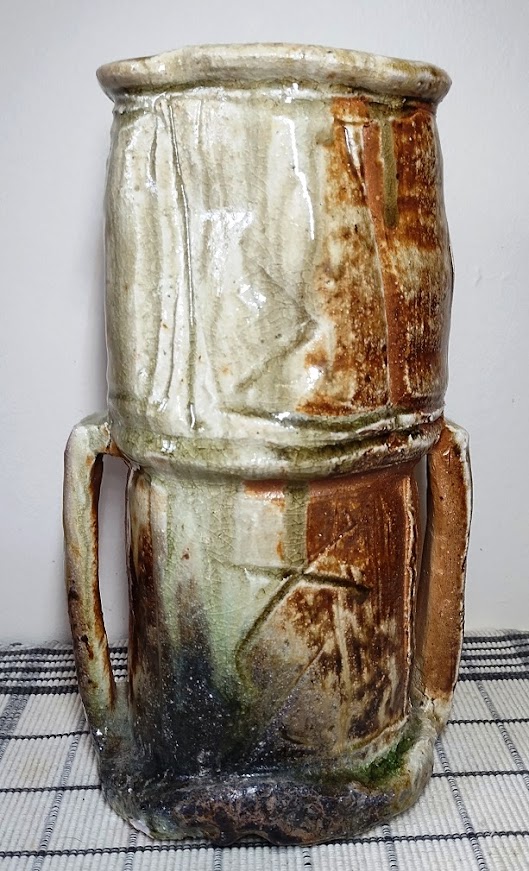244. KOJIMA Kenji 小島憲二,1953- , 伊賀耳付花入 Iga mimitsuki hanaire (Iga-ware vase with ear-lugs)
Kojima Kenji was born in Aichi Prefecture in 1953 and graduated from the Tokoname Ceramics Vocational High School in 1971. In 1973 he spent a year in Iga before moving to Bizen for a five-year apprenticeship with Konishi Tōzō. He returned to Iga in 1979 and built an anagama. He has exhibited with the Nihon Tōgeiten National Ceramics Exhibition, Asahi Tōgeiten Ceramics Art Exhibition, and Chūnichi International Ceramics Exhibition, as well as an impressive list of solo exhibitions in some of Japan’s top galleries. Pictures of many of his works can be found online.
Light gray clay, with the addition of many small feldspar-sand pebbles; kiln effects in the reddish brown range (hi-iro coloration) and natural-ash glazing in the cream to black range, with a glossy sheen on all parts of the exterior and some bidoro formation particularly on horizontal surfaces; the interior has some drips of natural-ash glazing and reddish-brown coloration from kiln effects, with very little sheen. Weight: 3.4 kg (7.7 lb). Height: 28.5 cm (11-1/4 in). Width: of rim, 12.7 cm (5 in); at widest point, 16.3 cm (6.5 in); of base, 13.3 x 15 cm (5-1/4 x 6 in).
This sits on a flat base, an irregular oval. There are two small paper labels attached to the base, presumably inventory marks; one reads “2,” and the other "MC 534.” The base is about a centimeter and a half high (1/2 in); the edges of the base extend beyond the bottom of the walls of the piece, forming a ledge of varying widths. The walls are divided into two, stacked sections, each a rough cylinder. The two are joined about 14 cm (5-1/2 in) above the base. The bottom section is roughly cylindrical. The top section is wider at the lower end, where it overhangs the bottom section a bit. Its walls move inward slightly toward the curled rim. The upper surface of the rim was flattened. The mouth is circular, but with five, irregularly shaped indentions, almost as if it were the outline of a five-petalled flower. Although Kojima called the handles by the traditional name of “ears,” they are straighter than most examples of pottery mimi, bowing outward slightly only toward the center of the vertical distance. The tops of the handles are attached at the join between the two sections, and the bottoms to the ledge formed by the upper surface of the base. Because of the orientation and shape of the upper section, from some angles the base appears to tilt. To judge from pictures of other examples of Kojima’s Iga-ware vases I found online, he often uses this two-part structure for vases.
On the lower section, on both the front and the back (arbitrarily defined as the space between the handles, with the side with the most hi-iro coloration designated the front), Kojima made two deep, vertical incisions the length of the cylinder. Between these two grooves, he incised two X’s with somewhat shallower cuts, The decoration on the top section is more irregular. A groove circles the section near its bottom. There are five, irregularly spaced vertical grooves. These tend to slope to the right as they move downwards. On both the front and the back, off to one side, there is a dent shaped like the > symbol. On the front, this dent is filled with lines creating a pattern of squares. On the back this shape was obscured by a heavy coating of natural ash glazing.
The surface texture of the piece ranges from quite smooth in the areas of heavy ash glazing to very rough at the edges and seams. The interior areas largely unaffected by the natural-ash glazing reveal that the clay used was very coarse.
This was fired unglazed. The color of the unaffected clay shows through in a few spots on the base and underneath one of the handles. In general the bottom cylinder exhibits more of the hi-iro and less of the natural ash glazing. The ash glazing is heaviest on the upper section on the right-hand side of the piece. On the back of the piece, the ash glazing flowed down over the bottom section, became darker as it neared the base. The horizontal areas on the lip, the tops of the handles, the groove where the two sections are joined, and the ledge where the base and the lower section meet exhibit many areas of the dark-green glass-like vitrification known as bidoro. Again, in looking at other examples of Kojima’s Iga-ware vases, this is a common pattern of kiln effects. He must have carefully placed the pieces in the kiln with the deliberate aim of creating such results.
The double structure of the piece is mirrored in the double structure of the kiln effects. On this piece, the handles appear to be supporting the upper section and redistributing its weight away from the lower section, much as flying buttresses do.
This came in a wooden box, inscribed by Kojima on the lid in three lines on the upper left and center: 伊賀 / 耳付 / 花入 Iga / mimitsuki / hanaire (Iga[-ware] / ear-lugs / vase); and signed Kenji 憲二 with Kojima’s seal stamped in red. Included in the box were a brown wrapping cloth and a short printed biography.
Purchased
from the Kura Monzen Gallery in Kyoto, Japan, in March 2024 (invoice and customs and shipping documents)











No comments:
Post a Comment